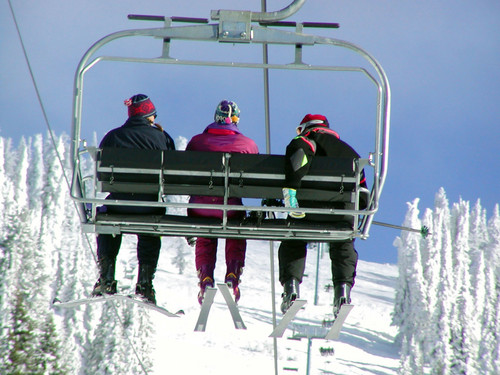Chair Lift Challenge
Lesson adapted from IEEE’s TryEngineering.org. Download the full .pdf
Summary
In this activity, teams of students 8 to 18 learn how engineers provide safe transportation in challenging conditions by designing a “chair lift” out of everyday items that can transport a ping-pong ball in a cup from the bottom of a “valley” to the top of a “mountain” along a clothes line or wire without the ball falling out.
Grade Level: 3 -12
Time: One to two 45-minute sessions
Learning objectives and outcomes:
After doing this activity, students should develop an understanding of:
- civil engineering
- engineering design and redesign
- teamwork and problem solving
- engineering’s role in addressing societal challenges.
- Abilities necessary to do scientific inquiry [K-12]
CONTENT STANDARD B: Physical Science. As a result of the activities, all students should develop an understanding of:
- properties of objects and materials [K-4]
- position and motion of objects [K-4]
- energy transfer [5-8]
- motions and forces [5-12]
- Abilities of technological design [k-12]
- Understandings about science and technology [k-12]
- Understandings about science and technology in society [grades 5-8]
- Changes in environments [k-4]
- Science and technology in local challenges [k-4]
- Populations, resources, and environments [5-8]
- Risks and benefit [5-8]
- Science and technology in local, national, and global challenges [9-12]
- Science as a human endeavor [k-4]
- History of science [5-8]
- Historical perspectives [9-12]
3-PS2-1. Plan and conduct an investigation to provide evidence of the effects of balanced and unbalanced forces on the motion of an object.
Energy
4-PS3-1. Use evidence to construct an explanation relating the speed of an object to the energy of that object.
Engineering Design
3-5-ETS1-1.Define a simple design problem reflecting a need or a want that includes specified criteria for success and constraints on materials, time, or cost.
3-5-ETS1-2.Generate and compare multiple possible solutions to a problem based on how well each is likely to meet the criteria and constraints of the problem.
3-5-ETS1-3.Plan and carry out fair tests in which variables are controlled and failure points are considered to identify aspects of a model or prototype that can be improved.
The Nature of Technology
Standard 1: Students will develop an understanding of the characteristics and scope of technology.
Standard 2: Students will develop an understanding of the core concepts of technology.
Technology and Society
Standard 4: Students will develop an understanding of the cultural, social, economic, and political effects of technology.
Standard 5: Students will develop an understanding of the effects of technology on the environment.
Standard 6: Students will develop an understanding of the role of society in the development and use of technology.
Standard 7: Students will develop an understanding of the influence of technology on history.
Design
Standard 8: Students will develop an understanding of the attributes of design.
Standard 9: Students will develop an understanding of engineering design.
Standard 10: Students will develop an understanding of the role of troubleshooting, research and development, invention and innovation, and experimentation in problem solving.
Abilities for a Technological World
Standard 11: Students will develop abilities to apply the design process.
Standard 13: Students will develop abilities to assess the impact of products and systems
- ping pong balls (1 per team)
- string
- floral wire
- pipe cleaners
- bendable aluminum wire
- straws
- paper towel tubes
- paper clips
- tape
- balloons
- glue
- foil
- plastic wrap
- pulley
- other items available in the classroom
- Student resource explaining aerial lifts (page 4 of .pdf)
- Student worksheet (pages 6 and 7 of .pdf)
1. Show students the student reference sheets. These may be read in class or provided as reading material for the prior night’s homework.
2. To introduce the lesson, consider asking the students if they have ever seen an aerial lift or ski lift. Have them consider the engineering challenges of building such a transportation system.
3. Teams of 3-4 students will consider their challenge, and consider how the available materials might be used to create a chair lift.
4. Teams will develop a detailed drawing showing their lift design, including a list of materials they will need to build it and the chair the ping pong ball will ride in.
5. Students build their lift, and test it under teacher supervision. Each lift must be able to transport the ball up and down “the mountain” without it dropping out of the chair developed to hold it.
6. Students should observe the chair lifts that other teams create, reflect on the challenge, and present their experiences to the class.
Have students transport a golf ball up and down the lift instead of a ping-pong ball – or require the chair lift to have two seats (two ping pong balls or a ping pong and a golf ball) – or have one basket going up while another is going down.
Resources
- Riblet Tramway Co. Learn about the civil engineer and the company he founded that has been building aerial tramways.
- Glossary of aerial lift terms. An illustrated guide to catenary (sag in the rope between towers), spacer, and other ski-lift terms.
- U.S. Forest Service history of tramways. (pdf)
- Lift construction of Aspen/Snowmass lift (Vimeo video)
See 12 unique ski lifts in action [YouTube 8:44]
[youtube]http://www.youtube.com/watch?v=CwhDTyCu3Qg[/youtube]
Filed under: Class Activities, Grades 6-8, Grades 9-12, Grades K-5
Tags: chair lift, Class Activities, Grades 6-8, Grades 9-12, Grades K-5, Lesson Plans, ski lift, Sports Engineering, Transportation, Winter









